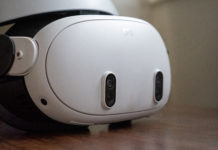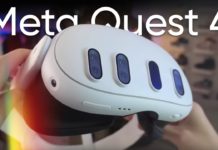Last Update on July 3, 2025
Boring learning is over. Today, classrooms are transforming, and virtual reality (VR) is playing an increasingly important role. Imagine this: instead of reading a chapter about space, you put on a headset and find yourself on Mars. Or better yet, you explore the inside of an erupting volcano without leaving your seat. That’s the magic of VR.
Far from being just a gadget, virtual reality offers incredible educational possibilities. Whether it’s visualizing abstract concepts, practicing languages, or traveling through time and space, it makes learning more vivid, more engaging… and sometimes even more fun. Ready to see how VR is revolutionizing education? Let’s dive in.
Why VR in Education Is a Revolution
Forget traditional lessons with textbooks and blackboards. With virtual reality, learning takes on a whole new dimension. Here, you don’t just listen to a teacher talk about Ancient Egypt: you literally walk inside a pyramid, examine the hieroglyphs up close, and explore the sites as if you were really there.
That’s the power of VR: turning a lesson into an experience. And these kinds of experiences stick with you. Students are no longer just spectators—they become active participants in their learning. The result? Better retention, greater focus, and above all, much more motivation.
Another advantage? Access to things you could never do in real life. Boarding a space shuttle, exploring the human body, manipulating 3D molecules… all things that are impossible in a traditional classroom, but made possible with VR in just one click.
It’s also a great motivational tool. Offering a student the chance to learn in VR means speaking their language. For a whole generation born with digital technology, it’s a natural and engaging way to learn.
Top 5 Ways VR Is Used in Schools
Wondering how virtual reality can actually be used in class? Good news: it fits many situations—and it brings every subject to life. Here are five ways VR is transforming students’ daily learning experiences.
1. Virtual Tours: Go on Adventures Without Leaving the Classroom
With a VR headset, a history or geography lesson becomes an exploration. Want to visit the Louvre, the Great Wall of China, or the ocean floor? It’s all possible. Students can walk through iconic sites, examine the details, and soak in the atmosphere. It’s way more impactful than a slideshow.
2. Scientific and Medical Simulations: Interact with the Invisible
Understanding a chemical reaction, a surgical procedure, or how a volcano works becomes easier (and safer) in VR. Students can test, observe, repeat—without any risk. It’s perfect for learning by experimenting, even with things that are invisible or too complex in real life.
3. Hands-On Training: Go Pro Mode
In technical schools or vocational training, VR can simulate real-life scenarios: flying a plane, fixing an engine, operating machinery… All without danger, expensive gear, or physical limitations—but with maximum realism. It’s ideal prep before hitting the real-world field.
4. Language Learning: Live the Language Instead of Studying It
Instead of listening to recordings, students can step into a restaurant in Tokyo or a market in Madrid. VR recreates real-life situations where they can interact, listen, and respond. The result: they don’t just learn vocabulary—they actually use the language.
5. Immersive Review Sessions: Memorize in 3D
Reviewing lessons in an immersive format is more fun and more effective. Some tools turn a lesson into an interactive journey: students answer questions to move forward, manipulate virtual objects, reconstruct diagrams in 3D… It’s playful, engaging, and it sticks.
Top Educational VR Apps and Platforms
Looking for apps to make learning more immersive? Here’s a selection of virtual reality tools that turn education into an interactive experience.
1. Lora VR
Lora VR is a free app that makes language learning fun and interactive. Available on Meta Quest headsets, it features mini-games and AI-powered dialogues to practice over ten languages, including French, Spanish, and Japanese. Lora VR is perfect for anyone who wants to learn while having fun.
2. ClassVR

ClassVR is an all-in-one educational platform offering hundreds of immersive learning experiences across different subjects. Teachers can guide students in real-time, making lessons much more interactive.
3. Mondly VR (Languages)
Mondly VR immerses users in everyday scenarios to practice foreign languages. It’s a natural and engaging way to build language skills.
4. Google Expeditions
Although development has stopped, Google Expeditions is still used in many schools for virtual field trips around the world, guided by teachers.
5. ENGAGE
ENGAGE is focused on higher education, allowing for virtual classes and conferences in fully customizable 3D environments.
6. VictoryXR
VictoryXR offers immersive lessons, especially in science and technical fields, aligned with U.S. school curricula.
7. Math World VR
Math World VR uses virtual reality games to help students practice mental math through fun mini-games. It offers multiple difficulty levels and makes learning math more engaging and accessible.
Concrete Benefits for Students and Teachers
We often hear about VR as a tech revolution… but in the classroom, what does it actually change? Spoiler: a lot. And not just for students.
Learning with the Body, Not Just the Eyes
VR enables learning through movement, exploration, and hands-on interaction. It’s no longer about passively receiving knowledge, but actively experiencing it. As a result, students are more engaged, which improves understanding and retention. Perfect for visual and kinesthetic learners—or just anyone who struggles with traditional methods.
Grasping the Abstract in an Instant
Some concepts are hard to visualize from a textbook or board. In VR, you can see a 3D molecule, enter a cell, or watch a weather system from the inside… What once felt abstract suddenly becomes clear. VR makes the invisible visible.
More Focus, Less Dropout
Let’s be honest: keeping a whole class focused is tough. But with a VR headset on, students are 100% engaged. No distractions, no phones—just them and the experience. And usually, they want more. Motivation rises, and the joy of learning returns.
Lessons That Fit Every Student
VR can adapt to each student’s pace and level. One student moves faster? They can explore further. Another needs to review? They can replay the content. Everyone learns at their own rhythm, with no pressure or constant comparison.
A Tool for Teachers, Not Just a Gadget
For teachers, VR isn’t here to replace lessons—but to enhance them. It allows for varied teaching methods, brings abstract ideas to life, and keeps attention high. Bonus: some platforms let teachers manage headsets remotely, track student progress, and even create their own scenarios.
Which VR Headsets Are Best for Learning?
No virtual reality without a headset—and not all are made for schools. Here are the models best suited for educational use: easy to operate and effective.
Meta Quest 2 and 3
The most widely used headset in schools. It’s wireless, delivers great image quality, and offers access to a large catalog of educational apps. The newer Quest 3 adds mixed reality features.
Pico 4
A solid alternative to the Quest. Lightweight, standalone, and smooth—it’s gaining popularity in European schools. The interface is simple, and performance is solid.
ClassVR
Designed specifically for education, this headset comes with a management platform for teachers. Content is preloaded, the interface is classroom-friendly, and it’s easy to get started.
HTC Vive / Valve Index
For advanced training, like in medicine or engineering, these headsets offer ultra-immersive experiences. However, they require a powerful PC and extra equipment, making them better suited to technical schools or universities.
Conclusion
One thing’s clear: virtual reality doesn’t just modernize education—it completely transforms the learning experience. Students aren’t just facing knowledge—they’re inside it. They live it, feel it, experience it. And that changes everything.
Sure, there are still challenges—budget, equipment, training… But the potential is real. With the right apps and a bit of creativity, VR can help teachers capture attention and help students learn differently. More than a tool, it’s a new educational language. And the school of tomorrow might just start… with a headset on your head.











